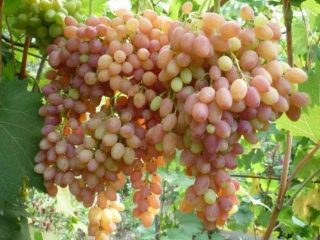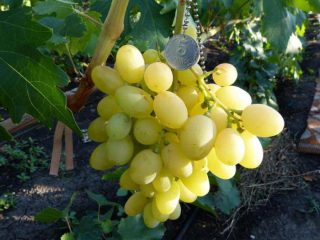Content
Table grape varieties are valued for their early ripening and pleasant taste. The Frumoas Albe grape variety of Moldavian selection is very attractive for gardeners. The grapes are quite unpretentious, complex-resistant, the bunches meet commercial standards, although they are loose and fragile. Berries are a great dessert.
Characteristic
Frumoasa Albe means White Beauty. The big name of the grape corresponds to the properties of the variety. It is a complex hybrid obtained from the varieties Guzal Kara and Save Villar 20-473. Frumoasa grapes have an average ripening period, 130-145 days from the time the buds open. In the southern regions and the Lower Volga region, the first clusters ripen by the end of August. Sometimes in the descriptions, amateurs note a mid-early harvest, which will ripen in 115-125 days. The vine holds clusters until frost, delighting with a tasty harvest that retains an excellent level of taste for a long time. In the northern regions, amateurs grow this variety as a cover crop.
The dessert grape variety Frumoas Albe, according to reviews, is often preferred over other vines. Its berries withstand the sun and do not crack in the rain after hot weather. The brushes ripen evenly, without peas.The high taste properties of Frumoas Albe grapes are undeniable, so its light amber harvest is almost entirely consumed fresh, as gardeners note in the description of the variety. The older the vine, the more intense the taste of the berries. The grape is easily propagated by cuttings; it is easy to make a lacy green summer curtain from it, given its undemanding nature and resistance to diseases. When pruning in autumn, several strong cuttings are left for spring planting.
Winegrowers are attracted to this variety by its stable and generous harvest. One bush produces a guaranteed 16 kg of grapes. With a good agricultural background, up to 40 kilograms or more can be harvested from an old bush. The vine ripens well, producing from 75 to 90% fruitful shoots. The clusters tolerate transportation and are long-term.
The frost resistance of Frumoas Albe grapes, according to the description of the variety and reviews from gardeners, is quite high: up to 22 degrees. Under snow cover, the vine is preserved even at -25 degrees. In the middle climate zone, the clusters take a long time to ripen, especially with frequent rains. The grape vine of this variety is popular among summer residents and in their gardens due to its resistance to fungal and viral diseases. The grapes are not affected by gray rot, mildew, or phylloxera. The variety is immune to oidium, anthracnose, leaf roller, and spider mite.
Description
As noted in the description of Frumoas Albe, the grape bushes are of medium height. Although some reviews talk about the vigorous growth of the vine, which spreads up to 2 m. Five-lobed, slightly wavy leaves of medium size, strongly dissected. The leaf veins are densely pubescent. The flowers are bisexual and are always well pollinated.
Cylindrical winged clusters are large and medium-sized, up to 19 cm long, 10-13 cm wide. Moderately loose in density. The weight of the bunches ranges from 300 to 700 g, the average is 500-600 g. The record harvest of grapes of this variety is 1-kilogram clusters.
The yellow-green berries of Frumoas Alba are round, sometimes slightly oval. Medium in size: 24 x 22 and 27-28 mm, weighing 5-8 g. Dots are visible on the skin with a waxy coating. It is of moderate density and easy to eat. The pulp is sweet, juicy, fleshy, with an inherent pleasant nutmeg aroma and harmonious taste. The berry contains 3-6 barely noticeable seeds. Sugar content – up to 17%, with acidity 7.5 g/l. The tasting rating of the variety is 8.2 points.
Advantages and disadvantages
According to reviews, Frumoas Alba grapes are in the top five easy to grow varieties. Besides this fact, it has many other advantages.
- Consistently high yield;
- Excellent taste, rich in nutmeg notes;
- Preservation of the taste of the bunches and the appearance of the berries remaining on the vine for a long time;
- Good ripening of bunches along the entire length of the shoot;
- Satisfactory commercial performance;
- Sufficient resistance to diseases.
The following are considered selection defects:
- Average frost resistance;
- The need to normalize the load of bunches per shoot: no more than two;
- Susceptibility to powdery mildew.
Landing
In accordance with the description of the variety, Frumoas Albe grapes should be planted in a sunny area, on the south side of any buildings, one and a half meters away from the wall.It is better to plant cuttings in the spring, but autumn plantings are also possible.
- The distance between grape seedlings is at least 2 m;
- Planting depth – 25-35 cm;
- The seedling is placed in the hole, tilted to the north;
- Sprinkle with soil, water generously, then mulch the root circle;
- An established cutting is planted 15 cm deeper than the size of the container where it grew.
tub culture
In city conditions, amateurs plant vines in pots, taking them out to balconies and loggias in the summer.
- Frumoas Albe grapes are grown in tubs, changing the container every year to a larger one;
- Attention should be paid to ventilating the room without creating drafts;
- The vine is fed with organomineral fertilizers;
- Preventive treatment of grapes against diseases is permissible with drugs permitted on premises.
Care
Frumoasa grapes, as emphasized in the description of the variety, are easy to care for. Regular watering, rationing of the vines, preventive treatments and preparation for winter are the recommended care for grapes of this variety. Each bush needs a strong support and trellises.
Watering
The seedling is given more attention, watering it moderately but constantly for better survival. The old vine is watered abundantly during the spring-summer drought. Grapes especially need moisture during flowering and ovary formation. Watering accompanies all root feeding of grapes.
Feeding
The harvest will be of better quality if you apply the fertilizers necessary for the plant at the root.
- For Frumoasa grapes, Alba is advised to use water-soluble forms of fertilizers so that they are more easily absorbed by the roots;
- Take 50 g of potassium and nitrogen fertilizers for each bush, which are used to fertilize the vines in the bud formation phase;
- Fertilizing will also be useful in the pea phase. Apply complex fertilizers for grapes;
- Doses of organomineral fertilizers are used according to the instructions.
Rationing
The Frumoasa vine produces many inflorescences, but does not tolerate overload with the harvest. The next year the berries are small and tasteless. First, one inflorescence is removed from the shoot. The time to remove the extra bunch comes when the berries grow the size of a pea. Choose the best brush, cut off the rest. Usually the cluster located below is pollinated worse. Experienced winegrowers leave only one bunch on one shoot.
Trimming
Most often, for the table grape variety Frumoasa Albe, a fan form of growth is used on a high trunk with a load of up to 22 shoots. Usually, a fan of four arms is first formed on a single-plane trellis. With this arrangement, the bunches receive the most optimal dose of sunlight, which they urgently need for high-quality ripening. In the fall, shoots are cut to 8 eyes, or short, which is preferable, to two or three buds. The total load on a bush of this variety is up to 35 eyes.
Preparing for winter
For the first year of growth, only one shoot is left on the young vine. At the end of October or November, grape trunks with lower eyes are sprinkled with earth and mulch, covering up to 30 centimeters from below. Such shelters serve as an additional guarantee of the preservation of the bush. Water does not penetrate through the ground to the roots during winter thaws, and the grapes do not freeze. Old vines are bent down, laid on the ground, sprinkled with sawdust, leaves, and spruce branches. When snow falls, it is raked up to the trunk. In spring, compacted snow must be removed.
Protection from diseases and pests
In autumn, after leaf fall, grape shoots are sprayed with iron sulfate.
With the arrival of warmth, the grapes are lifted onto supports, tied up and treated with Bordeaux mixture to prevent diseases and overwintered pests. Fungicides are used prophylactically at the bud stage, after the formation of ovaries and a month after the previous treatment.
Sunny fruits with a unique vitamin and mineral composition are good for health. Every passionate gardener can grow a vine and use its rich gifts.
















Frumoasa Albe has been growing with me for 10 years. This is the most delicious and very muscat grape. Guests who taste it with me consider it the most delicious out of 50 varieties (GF). But two years ago I overloaded it and now for a very long time it cannot return to normal in terms of vine growth, and therefore in terms of yield. Although it is considered early/medium. or medium ,
It is ripening well for me.